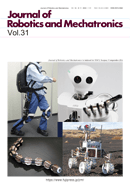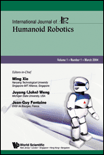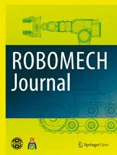
Journal of Robotics and Mechatronics
Scope & Guideline
Innovating Connections Between Theory and Application
Introduction
Aims and Scopes
- Robotics Design and Control:
This area encompasses the methodologies for designing robotic systems, including kinematics, dynamics, and control algorithms, to enhance performance in real-world applications. - Human-Robot Interaction:
Research in this field studies how robots can effectively and safely interact with humans, focusing on assistive technologies, social robots, and enhancing user experience. - Mechatronic Systems and Components:
The journal publishes works on the integration of mechanical, electronic, and software components in mechatronic systems, emphasizing innovation in actuators, sensors, and control systems. - Applications in Healthcare and Rehabilitation:
A significant focus is on the use of robotics in medical applications, including surgical robots, rehabilitation devices, and systems designed to assist elderly or disabled individuals. - Autonomous Systems and Navigation:
This includes research on autonomous mobile robots, drones, and unmanned vehicles, focusing on navigation, path planning, and obstacle avoidance in complex environments. - Soft Robotics and Biomimicry:
The journal explores the development of soft robotic systems inspired by biological organisms, emphasizing flexibility, adaptability, and new materials.
Trending and Emerging
- AI and Machine Learning in Robotics:
Recent publications increasingly incorporate artificial intelligence and machine learning techniques to enhance robot autonomy, learning capabilities, and adaptability in dynamic environments. - Teleoperation and Remote Systems:
With the rise of teleoperated systems, particularly in healthcare and disaster response, there is a growing focus on developing advanced teleoperation technologies that ensure effective human-robot collaboration. - Human-Centric Robotics:
Research is trending towards developing robots that prioritize human needs, focusing on user-centered design, emotional interaction, and assistive technologies that enhance quality of life. - Sustainable and Eco-Friendly Robotics:
Emerging themes include the design and application of robots that promote sustainability, such as those used for environmental monitoring, rehabilitation, and disaster response. - Soft and Compliant Robotics:
There is an increasing interest in soft robotics, which emphasizes flexibility and adaptability, leading to innovations in materials and designs that mimic biological systems.
Declining or Waning
- Traditional Industrial Robotics:
Research focused solely on traditional industrial robots and automation has seen a decrease, as the field shifts towards more intelligent, adaptable systems that integrate AI and machine learning. - Basic Sensor Technology:
While sensor technology remains important, the emphasis on fundamental sensor research has waned in favor of more integrated approaches that combine multiple sensing modalities and smart data processing. - Passive Assistive Devices:
There is a noticeable decline in research on passive assistive devices, as the focus shifts towards active and adaptive systems that provide more effective support and rehabilitation.
Similar Journals

AUTONOMOUS ROBOTS
Shaping Tomorrow’s Autonomous Solutions.AUTONOMOUS ROBOTS, published by SPRINGER, is a leading academic journal that serves as a pivotal platform for the dissemination of cutting-edge research in the field of Autonomous Robotics. With an ISSN of 0929-5593, this esteemed journal has been at the forefront of innovation since its inception in 1994, and it continues to thrive with a vision extending to 2024 and beyond. Recognized in the Q1 category of Artificial Intelligence, it boasts a commendable ranking of #85 out of 350 in Computer Science and Artificial Intelligence, positioning it within the 75th percentile of researchers' preferred publications. The journal features a range of subjects related to autonomous systems, including but not limited to robot perception, action planning, multi-agent systems, and autonomous interactions, catering to an audience that spans researchers, industry professionals, and students alike. Scholars can access a wealth of peer-reviewed articles that contribute to both theoretical frameworks and practical applications, ensuring the relevance of the work published within its pages. Located in Dordrecht, Netherlands, AUTONOMOUS ROBOTS exemplifies a commitment to advancing the science of robotics, making significant contributions to the knowledge base and inspiring new developments within the field.

Frontiers in Robotics and AI
Shaping Tomorrow's Technologies with Cutting-Edge ResearchFrontiers in Robotics and AI is a leading journal dedicated to the exploration and dissemination of groundbreaking research in the fields of robotics and artificial intelligence. Published by FRONTIERS MEDIA SA in Switzerland, it has established itself as a vital resource for academics, professionals, and students since its inception in 2014. With an impressive Open Access model, the journal ensures that high-quality research is accessible to a global audience, fostering collaboration and innovation. The journal is recognized for its distinguished impact in the academic community, achieving Q2 quartile rankings in both Artificial Intelligence and Computer Science Applications as of 2023. It currently holds a solid position in Scopus rankings, with a rank of #123 out of 350 in Artificial Intelligence and #223 out of 817 in Computer Science Applications, reflecting its robust contribution to these dynamic disciplines. The journal's scope encompasses a wide range of topics, including but not limited to autonomous systems, machine learning, and human-robot interaction, making it an essential platform for innovative ideas and advanced research.

International Journal of Humanoid Robotics
Unveiling the Potential of Humanoid InnovationInternational Journal of Humanoid Robotics, published by World Scientific Publishing Co Pte Ltd, is a leading platform for researchers and practitioners in the fields of artificial intelligence and mechanical engineering. With an ISSN of 0219-8436 and an E-ISSN of 1793-6942, this journal has established itself as a significant resource since its inception in 2004. Spanning various topics from robotic design and control to human-robot interaction, it serves a diverse interdisciplinary audience. The journal’s impressive ranking in the Scopus database, positioned in the third quartile for both categories in 2023, reflects its growing impact in the academic community. Although not open access, the journal provides crucial insights that advance the understanding of humanoid robotics and foster innovative solutions to real-world challenges. Researchers, professionals, and students are encouraged to engage with this essential resource as it continues to shape the future of robotics through rigorous scientific inquiry and scholarly collaboration.

Advanced Intelligent Systems
Transforming Ideas into Intelligent Solutions.Advanced Intelligent Systems, published by WILEY, stands as a prominent Open Access journal dedicated to the interdisciplinary exploration of intelligent systems, with a focus on materials science, engineering, and computer science. Since its establishment, the journal has fostered innovative research, providing a platform for the dissemination of findings that push the boundaries of artificial intelligence, human-computer interaction, and systems engineering. Although it is relatively new, having converged from 2023 to 2024, it ranks within various Scopus categories, showcasing its growing influence in fields such as mechanical engineering and computer vision. With an emphasis on accessibility, the journal has been Open Access since 2019, ensuring that cutting-edge research is available to a global audience of researchers, professionals, and students, thus driving forward the frontiers of intelligent systems development.

ROBOMECH Journal
Empowering Innovation in Robotics and AI for a Better TomorrowROBOMECH Journal, published by SpringerNature, is a prominent open-access journal dedicated to the fields of robotics, mechanical engineering, and artificial intelligence. Established in 2014, the journal has quickly established itself as a vital platform for disseminating innovative research in control and optimization, instrumentation, and modeling and simulation, earning a commendable Q2 ranking in Mechanical Engineering and multiple Q3 rankings across other relevant fields in 2023. With a commitment to facilitating accessible knowledge sharing, ROBOMECH Journal promotes cutting-edge research that drives advancements in both theoretical frameworks and practical applications within the robotics community. Scholars, engineers, and professionals seeking to contribute to or stay informed about the latest developments in these dynamic fields will find the journal's rich array of articles invaluable. With its open-access model, all published research is freely available, ensuring wide dissemination and increased visibility for authors, thus fostering collaboration and innovation across disciplines.

ROBOTICS AND COMPUTER-INTEGRATED MANUFACTURING
Elevating Industry Standards with Cutting-Edge ResearchROBOTICS AND COMPUTER-INTEGRATED MANUFACTURING is a prestigious, peer-reviewed journal published by PERGAMON-ELSEVIER SCIENCE LTD. With an impressive impact factor and rankings placing it in the Q1 quartile across multiple categories, including Computer Science Applications, Control and Systems Engineering, and Industrial and Manufacturing Engineering, this journal is a leading source for cutting-edge research in its field. Since its inception in 1984 and covering a broad range of topics until 2025, it provides an essential platform for scholars and practitioners aiming to explore innovative technologies and methodologies that integrate robotics and computing in manufacturing processes. Although it does not offer an Open Access option, its rigorous editorial standards and high visibility in academic circles make it a vital resource for anyone seeking to contribute to or stay informed about advancements in these dynamic fields. As an authoritative voice in the landscape of industrial research, ROBOTICS AND COMPUTER-INTEGRATED MANUFACTURING inspires engaging discussions and collaborations among researchers, professionals, and students alike, driving forward the evolution of smart manufacturing solutions.

MECHATRONICS
Connecting Disciplines, Shaping the Future of EngineeringMECHATRONICS is a prominent journal published by PERGAMON-ELSEVIER SCIENCE LTD, focusing on the interdisciplinary fields of mechanical engineering, control and systems engineering, electrical and electronic engineering, and computer science applications. With an ISSN of 0957-4158, this journal has been a cornerstone in advancing knowledge and innovation since its inception in 1991. Known for its rigorous peer-review process and high-quality research outputs, MECHATRONICS holds prestigious rankings, including Q1 in both Electrical and Electronic Engineering and Mechanical Engineering for the year 2023, reflecting its influential position in the academic community. The journal caters to a diverse audience of researchers, professionals, and students, making it an essential resource for those looking to stay at the forefront of technological advancements in mechatronic systems. Although it does not currently offer open access, its wealth of insights and findings is indispensable for anyone pursuing excellence in engineering methodologies and applications.

Science Robotics
Exploring the Future of Robotics InnovationScience Robotics, published by the American Association for the Advancement of Science, is a leading journal that explores cutting-edge advancements in the field of robotics, emphasizing the intersection of artificial intelligence, mechanical engineering, and control optimization. With its ISSN 2470-9476, this prestigious journal holds an impressive Q1 ranking across pivotal categories for 2023, including Artificial Intelligence, Computer Science Applications, Control and Optimization, and Mechanical Engineering. It has garnered renowned recognition in the academic community, highlighted by its high Scopus rankings—placing it in the top tier with a 99th percentile rank in Mathematics for Control and Optimization and Computer Science Applications, and maintaining a 98th percentile in Artificial Intelligence. While the journal is not currently open access, it serves as a vital repository of knowledge for researchers, professionals, and students seeking to stay at the forefront of robotic innovations. Operating from its base in Washington, DC, Science Robotics aims to disseminate world-class research that catalyzes future developments in robotics and automation technologies, making it an essential resource for those engaged in the scientific study and application of these transformative fields.

JOURNAL OF INTELLIGENT & ROBOTIC SYSTEMS
Leading the Charge in Intelligent EngineeringJOURNAL OF INTELLIGENT & ROBOTIC SYSTEMS, published by Springer, is a premier interdisciplinary journal that focuses on the rapidly evolving fields of artificial intelligence, robotics, and their applications across various engineering domains. With an impressive impact factor and ranked in the Q1 and Q2 quartiles of multiple relevant categories—including Electrical and Electronic Engineering, Control and Systems Engineering, and Mechanical Engineering—this journal is essential for researchers, industry professionals, and graduate students seeking to stay at the forefront of innovation in intelligent systems. The journal publishes high-quality research articles, reviews, and technical notes that contribute to advancing theory, practice, and the integration of intelligent robotic systems better suited to meet contemporary challenges. Founded in 1988, and with a robust indexing in Scopus, the journal continues to foster scholarly discourse and serves as a critical resource for those passionate about the future of intelligent technologies, despite not currently providing open access options.

International Journal of Automation and Computing
Exploring the Frontiers of Applied Mathematics and TechnologyInternational Journal of Automation and Computing, published by SPRINGERNATURE, is a premier academic journal dedicated to advancing knowledge in the fields of applied mathematics, computer science applications, control and systems engineering, and modeling and simulation. With an impressive impact factor and consistently ranked in the Q1 Quartile for its respective categories in 2023, the journal is recognized for its high-quality research and contributions to the automation and computing sectors. This journal provides open access to its articles, promoting the dissemination of innovative ideas and methodologies across a global audience. Based in China but serving an international community, the journal is key for researchers, professionals, and students looking to stay at the forefront of automation and computing technologies. Its rigorous peer-review process ensures that published works meet the highest scientific standards, making it an essential resource for those seeking to deepen their understanding and engage in cutting-edge research.